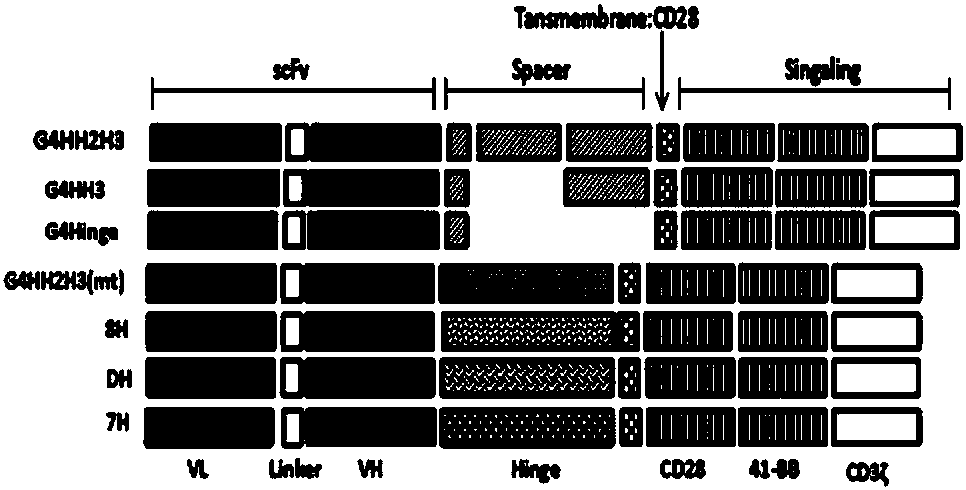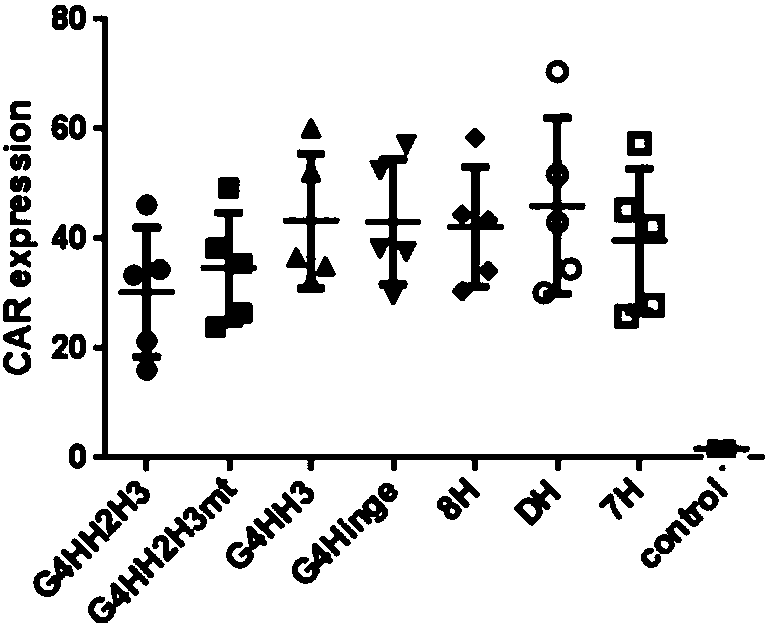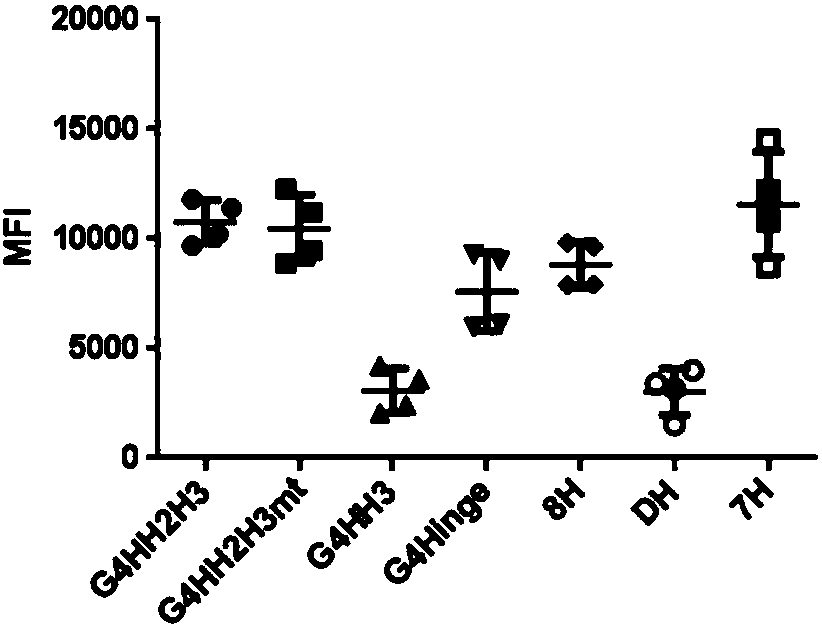Transformed hinge and application thereof in construction of CAR skeleton
A hinge region, single-chain antibody technology, applied in the hinge region and its application in the construction of CAR skeleton, the hinge region, the application field in the construction of CAR skeleton, can solve the problem of CAR-T treatment with little effect, patient recurrence, CAR-T T cells affect the effectiveness of killing and other issues
- Summary
- Abstract
- Description
- Claims
- Application Information
AI Technical Summary
Problems solved by technology
Method used
Image
Examples
Embodiment 2
[0068] Example 2 Construction of chimeric antigen receptor viruses containing different hinge regions
[0069] In order to verify the influence of hinge regions with different structures on the continuity and tumor infiltration of CAR-T in vivo, experiments were carried out with CAR-T targeting PSCA as an example. designed as figure 1 CARs with 5 different hinge structures shown.
[0070] 1 Synthesize the chimeric antigen receptor gene sequence targeting PSCA containing the hinge sequence designed above
[0071] Synthesize single-chain antibodies containing leader peptide (also known as signal peptide) (abbreviated as LP), anti-human PSCA antigen, 6 different hinge regions, CD28 transmembrane region (abbreviated as TM), and intracellular signal domains of CD28, CD137 and CD3 The CAR structure.
[0072] 2 Construction of lentiviral vectors expressing chimeric antigen receptors
[0073] The following primers were designed and synthesized by a biotechnology company. The speci...
Embodiment 3
[0097] Example 3 Detection of the ability of CAR to transfect T lymphocytes
[0098] 1 Isolation of human peripheral blood mononuclear cells
[0099] Collect about 60ml of peripheral blood with a blood collection tube, divide it into a 50ml centrifuge tube, add 7.5ml of hydroxyethyl starch to dilute it; naturally settle at room temperature (18-25°C) for about 30min, collect the upper plasma, centrifuge the collected upper plasma and use physiological Resuspend the precipitate in saline, add it to the lymphocyte separation solution in a volume ratio of 1:1, and perform gradient centrifugation; after centrifugation, the centrifuge tube is divided into: the first layer: plasma layer; the second layer: annular milky white lymphocytes Cell layer; third layer: transparent separation liquid layer; fourth layer: red blood cell layer; take the second white lymphocyte layer, wash twice with normal saline, centrifuge for 5 min, resuspend cells in normal saline, add 10% FBS-containing Hu...
Embodiment 4
[0106] Example 4 Detection of long-term proliferation ability of CAR-T cells
[0107] The proliferation of infected PSCA-CAR-T cells under normal culture conditions was detected; the CAR-T cells obtained in Example 3 were cultured for 10 days using the culture method in Step 2 of Example 3. The 24-well plate was coated with PSCA antigen for four times overnight, and 1*10^6 / well of CAR-T cells were plated on the 24-well plate coated with PSCA antigen, and the survival time of CAR-T cells after antigen stimulation was observed. like Figure 4 As shown, the number of CAR-T cells was counted by a cell counter on the 3rd day, the 6th day, the 9th day and the 12th day after stimulation, and the CAR-T cell proliferation fold was calculated. According to the experience of in vivo experiments, antigen stimulation was performed every 7 days, Figure 4 As a result, the CAR-T cells no longer proliferated after the third antigen stimulation, so the experiment was terminated after the 15t...
PUM
 Login to View More
Login to View More Abstract
Description
Claims
Application Information
 Login to View More
Login to View More - R&D
- Intellectual Property
- Life Sciences
- Materials
- Tech Scout
- Unparalleled Data Quality
- Higher Quality Content
- 60% Fewer Hallucinations
Browse by: Latest US Patents, China's latest patents, Technical Efficacy Thesaurus, Application Domain, Technology Topic, Popular Technical Reports.
© 2025 PatSnap. All rights reserved.Legal|Privacy policy|Modern Slavery Act Transparency Statement|Sitemap|About US| Contact US: help@patsnap.com



